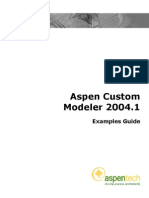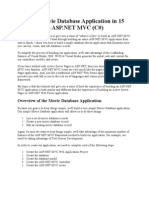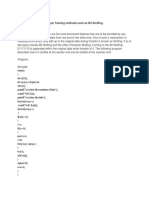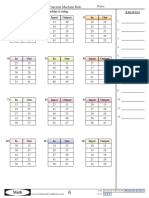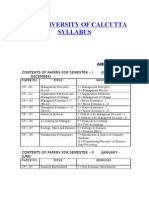GCSE Computer Science SQL and Databases Revision Notes
Uploaded by
Tim MillardGCSE Computer Science SQL and Databases Revision Notes
Uploaded by
Tim MillardSECTION 1 – THINGS TO REMEMBER IN PYTHON
Strings are text in python. When
printing them you must put them in
brackets and surround them with
quotation marks. The same does not
apply for if statements.
Put a colon after an if statement.
After a colon,
put a full tab This is a comparison operator. It could
space as an also be: !=, <>, >, <.
indent. This
command This is a variable, it has been defined.
All variables must be defined, we use
executes when
the statement is an = sign for this.
true.
SECTION 2 – LOOPS IN PYTHON
In this for loop, the variable “i” is assigned to the first value in the range, this is then printed in the
second line. Next, the “i” variable picks up the second value which is then printed. This process is
repeated until the end of the range. This would altogether produce:
In this loop, “var_x” starts as zero, which is less than 100. So the next line is executed and the print
statement is called. The next line adds 1 to “var_x”. As this is the end of the loop, x is once again
checked to see if it is less than 100. This cycle is then continued until var_x = 99. This would
altogether produce:
This repeats even more
until “var_x” = 99
3
In this loop variable values, text and a calculation are concentrated (joined) in one line. The text
(strings are contained between the quotes in green. The commas are used to concentrate the
different elements of code. In the print statement the first “var_x” gives its value, and the “y*x”
does the calculation. This would altogether produce:
Notice that its like a times
table
SECTION 3 – ARRAYS IN PYTHON
This is an array variable. Array variables are variables that contain other variable. If I printed this
array, it would look like this:
But if I add a for loop like this:
The end result would print vertically like this:
You might also like
- Unit 2: Expressions and Variables For LoopsNo ratings yetUnit 2: Expressions and Variables For Loops15 pages
- Introduction To Programming With PythonNo ratings yetIntroduction To Programming With Python45 pages
- Lec 6 - Looping Statements in Python With ExamplesNo ratings yetLec 6 - Looping Statements in Python With Examples36 pages
- ENR100 Bilgisayar Programlamaya Giriş Temel Python v2.0No ratings yetENR100 Bilgisayar Programlamaya Giriş Temel Python v2.0101 pages
- Python 02-Expressions-Variables-ForloopsNo ratings yetPython 02-Expressions-Variables-Forloops15 pages
- Practical_introduction_to_Python - UG ClassNo ratings yetPractical_introduction_to_Python - UG Class84 pages
- Q-Step WS 02102019 Practical Introduction To PythonNo ratings yetQ-Step WS 02102019 Practical Introduction To Python88 pages
- This Comprehensive Python Cheat Sheet Covers Everything You Need To Know To Get Started With PythonNo ratings yetThis Comprehensive Python Cheat Sheet Covers Everything You Need To Know To Get Started With Python185 pages
- Python Quick Reference Guide Heinold PDFNo ratings yetPython Quick Reference Guide Heinold PDF9 pages
- Loops in Python - Jupyter Notebook_52643069955dc0969f5fd149850a7462No ratings yetLoops in Python - Jupyter Notebook_52643069955dc0969f5fd149850a746210 pages
- Lab Task # 2 Introduction To Programming With PythonNo ratings yetLab Task # 2 Introduction To Programming With Python5 pages
- Class XII - L1 - Python Revision Tour 1No ratings yetClass XII - L1 - Python Revision Tour 118 pages
- Introduction To Programming With PythonNo ratings yetIntroduction To Programming With Python34 pages
- An Approach To Carry Out Consistency Analysis On RequirementsNo ratings yetAn Approach To Carry Out Consistency Analysis On Requirements6 pages
- 1.create A Movie Database Application in 15 Minutes With ASPNo ratings yet1.create A Movie Database Application in 15 Minutes With ASP24 pages
- CPH & Adm: An Old Dog Learning New Tricks - SAP Education Course ADM107 - Day 1 (Of 2)No ratings yetCPH & Adm: An Old Dog Learning New Tricks - SAP Education Course ADM107 - Day 1 (Of 2)13 pages
- Computers: Tools For An Information AgeNo ratings yetComputers: Tools For An Information Age51 pages
- Determining Function Machine Rule: Sub 8 Add 8 Add 6 Sub 10 Sub 11 Add 4 Add 7 Sub 14 Sub 11 Sub 15 Add 13 Add 5No ratings yetDetermining Function Machine Rule: Sub 8 Add 8 Add 6 Sub 10 Sub 11 Add 4 Add 7 Sub 14 Sub 11 Sub 15 Add 13 Add 53 pages
- Platform LSF Version 7.5 Administration GuideNo ratings yetPlatform LSF Version 7.5 Administration Guide834 pages
- 1.1.1.5 Lab - Cybersecurity Case StudiesNo ratings yet1.1.1.5 Lab - Cybersecurity Case Studies2 pages
- SAP123 - Loading Material Masters With LSMW Direct Input MethodNo ratings yetSAP123 - Loading Material Masters With LSMW Direct Input Method14 pages
- 02 - Control Instructions - Exploring CNo ratings yet02 - Control Instructions - Exploring C23 pages
- Database Management System: Dr. Anand Bihari SJT Annex-203N Anand - Bihari@vit - Ac.inNo ratings yetDatabase Management System: Dr. Anand Bihari SJT Annex-203N Anand - Bihari@vit - Ac.in36 pages
- Firmware Rewriting Bizhub 223 283 363 423 PDFNo ratings yetFirmware Rewriting Bizhub 223 283 363 423 PDF15 pages
- Genetic Algorithm and Its Application: M.SivagamiNo ratings yetGenetic Algorithm and Its Application: M.Sivagami26 pages
